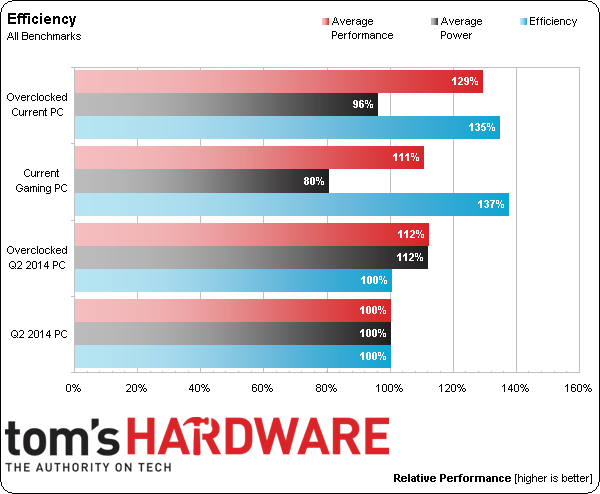System Builder Marathon Q3 2014: Budget Gaming PC
Did We Build a Better Machine?
Performance
I honestly didn’t expect my new Pentium-based gaming PC to fare as well as it did in stock form. It not only out-works last quarter’s build, but even out-games my previous overclocked efforts by remaining playable at higher settings. Once its Pentium G3258 and Radeon R9 270 graphics card are fully optimized, it stands toe-to-toe in almost every threaded workload, while its victories became far more pronounced.
The real beauty of this rig is easy to gloss over when we summarize average frame rates: think about the best playable settings. In all four games, this quarter’s stock configuration can be tweaked to handle higher resolutions and details than last’s quarter’s overclocked PC. I fully expected that the Pentium would require overclocking to exploit this build’s increased graphics muscle. However, it only failed to cope with the demands of Ultra quality in Far Cry 3. Instead, our new PC allowed 2x MSAA with Very High details in Full HD, and remained playable at 4800x900 at High details. Last quarter’s PC couldn’t survive those settings, even overclocked.
And of course, higher average frame rates mean little if the gaming experience isn’t smooth. I’m happy to report that today's machine exhibits no noticeable lag, micro-stutter, or frame time variance issues in the four games we tested. If anything, it sustains higher minimum frame rates. Marginal benchmark results actually feel smoother in-game than last quarter’s hardware.
Efficiency
There are no surprises; more performance, while consuming less power, equals greater efficiency.
Value
Charting value would be redundant, since only fifty cents separate our two hardware budgets. The system cost, including the case, DVD burner, and Windows 8.1, jumped by only three dollars. Once we factor in the eight-dollar spike we absorbed by securing 8 GB of RAM, it’s fair to just look at the performance charts and forget minor price fluctuations. Apart from a few threaded application workloads, our new PC simply delivers more performance and value in stock and overclocked trim.
This success story can’t be credited to the unlocked Pentium alone. In fact, at 4.1 GHz, we didn’t even get a particularly good sample. Chris was able to squeeze a stable 4.4 GHz from his using the same H81-based motherboard and cooler. We are certainly happy to have more options to consider for budget-oriented gaming. But the biggest prize in this comparison comes from bowing out of the megahertz war and embarking on milder “free overclocking” instead. By leveraging the relatively potent capabilities of a $45 MSI motherboard and bundled Intel cooler, we lowered the platform costs enough to outfit a Radeon R9 270 graphics card. The price drop on this beefier AMD offering was a key factor in making that a reality.
Get Tom's Hardware's best news and in-depth reviews, straight to your inbox.
Current page: Did We Build a Better Machine?
Prev Page Performance Summary-
g-unit1111 I would personally love to get a Pentium G3258 for my HTPC, it's only like $50 at Micro Center and the motherboard is $70 at Newegg. Hmm... decisions, decisions. :lol:Reply -
ScienceGuy3 What about the Frame Times? Isn't this processor notorious for bad frame times in heavily threaded games like BF4?Reply -
elbert Replyserves up to 30 A across its +12 V rails.
Its rated to serve up to 30 Amps but can do far more. Tests on this little gem shows it can output 22amps on each rail and maxes out around 38~39 Amps on both. Im paraphrasing a popular power supply testing site. Max wattage is about 553ish which is a good deal more than rated. This power supply can't be certified due to it lacks a circuit required but exceeds 80 percent efficiency. -
de5_Roy a lot of things went right for this build: amd introduced the full pitcairn/curacao gpu based r9 270 under 150w, needing single 6 pin pcie power connector, cryptocurrency craze was over and gfx card prices came down, hdd prices came down to sane levels, cpu-overhead-reducing gfx card drivers came out, intel released an unlocked dual core cpu and allowed o.c. bioses....Reply -
jdwii I'm just not sure for one they didn't show latency times. I'm pretty sure this build will suck for future gaming to such as GTA5.Reply
http://www.tomshardware.com/reviews/pentium-g3258-overclocking-performance,3849-5.html
When toms reviewed this CPU it was shown to have poor latency
For a 500$ build i would probably do a 6300+265 build. 600$ i would probably jump the build up to a I5+265 or 8320+270X. -
Onus No stuttering? Very interesting; looks like more testing might be needed, but perhaps settings can also be adjusted.Reply -
akula2 Since this CPU is super performer on various fronts (single core), so why not this config?Reply
Pentium G3258 - $69.97
NZXT Kraken X31 - $73.98
Asus MAXIMUS VII HERO - $203.99
G.Skill Trident X Series 16GB (2 x 8GB) DDR3-2133 - $184.99
Crucial M550 1TB 2.5" SSD - $447.98
Asus GeForce GTX 970 4GB STRIX - $349.99
NZXT Phantom 530 (White) - $121.98
EVGA 650W ATX12V - $64.99 (not sure about its power good signal value?)
Asus DRW-24B1ST/BLK/B/AS DVD/CD Writer - $16.99
Asus VG248QE Monitor - $264.99
D-Link DWA-171 802.11a/b/g/n/ac USB 2.0 - $29.27
Logitech MK550 w/Laser Mouse - $49.99
Corsair Vengeance 2100 - $79.99
Logitech Z506 155W 5.1ch - $69.99
Microsoft Windows 8.1 Professional (32/64-bit) - $170.99
Total: $2200
What you guys think? Usage? Racing Games at homes, audio/video encoding etc. I don't need K CPUs because I'm not in a hurry in this case.
Power source: 100% green aka Solar energy. -
alchemy69 Very similar to the system I just put together for myself except that I felt a 260X was more than enough power for the GPU and put the savings towards a small SSD for the boot drive.Reply


